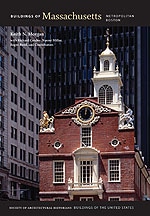
River Street is the primary artery of Hyde Park, paralleling the Neponset River from the Tileston and Hollingworth Paper Mill on the east (c. 1850–1970s, 864 River Street) to the Dedham Cotton Manufacturing Company complex on the west (1866–1867, 1576–1608 River Street). Centered along this industrial corridor and between two railway stations, Cleary and Everett squares rose as the civic core for Hyde Park. From the 1890s through the 1920s, substantial public buildings were constructed here. Cram, Wentworth and Goodhue designed the granite Gothic Revival Christ Church, Episcopal (1894, 1220 River Street) for Hyde Park's oldest congregation. The YMCA (1902–1903, 1137 River Street), a Classical Revival design by Thomas Rowe in brick with rusticated granite first story, was one of three gifts to Hyde Park from local resident and lawyer Edward Ingersoll Brown (the others were the Hyde Park Public Library [HP2] and the Hyde Park High School, 1901–1903, now the Rogers Junior High School in Webster Square). Built after the 1912 annexation of Hyde Park by Boston, the Municipal Building (1921, Desmond and Lord, 1179 River Street) provides a dominant focus for this civic center, a red brick and cast-stone Georgian Revival design with





